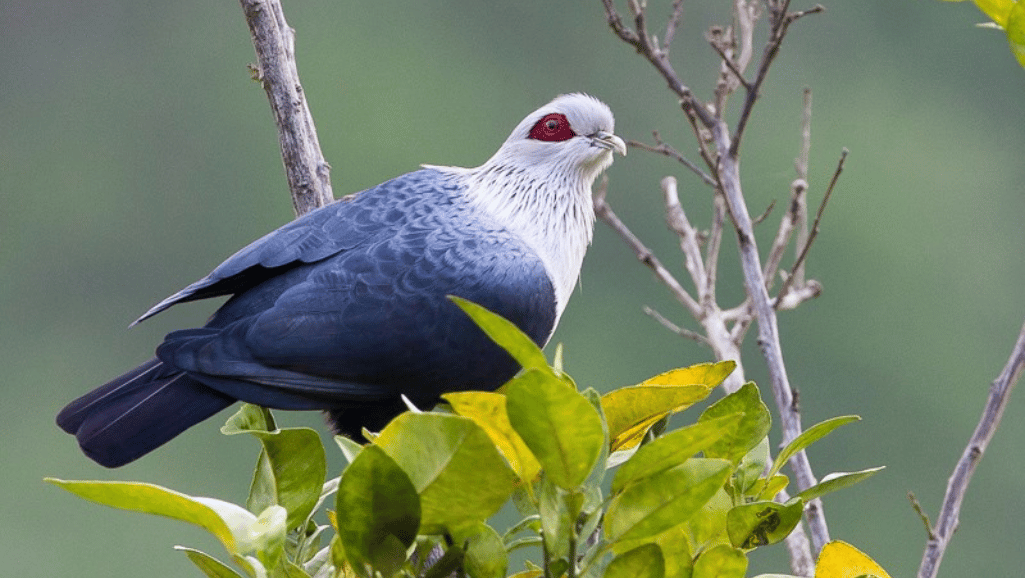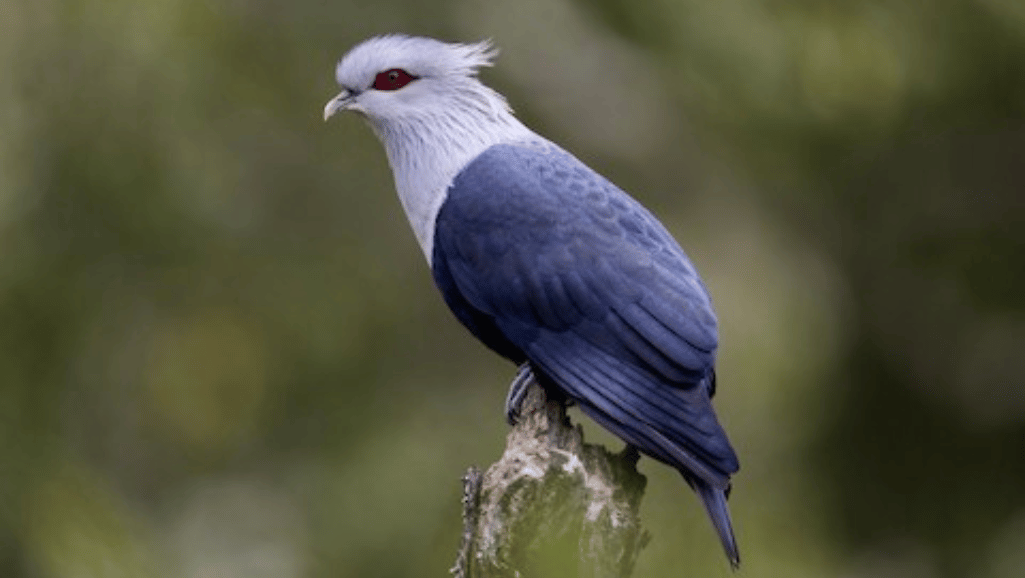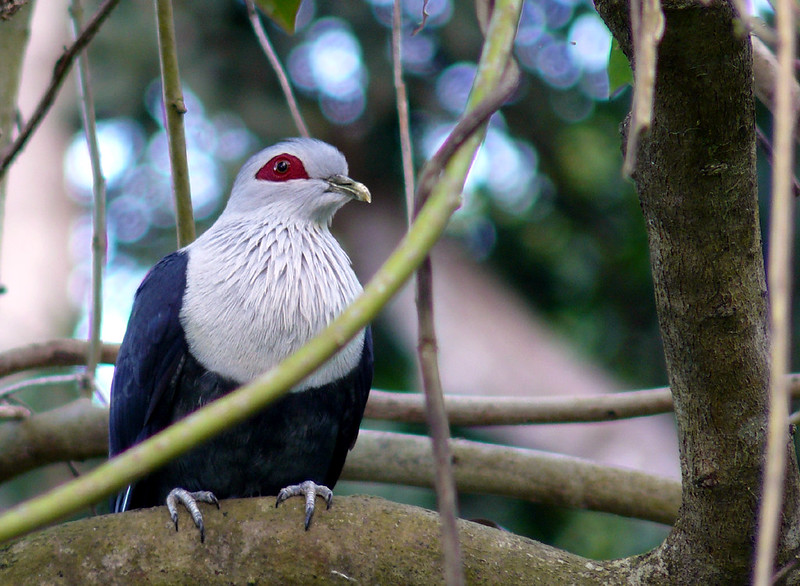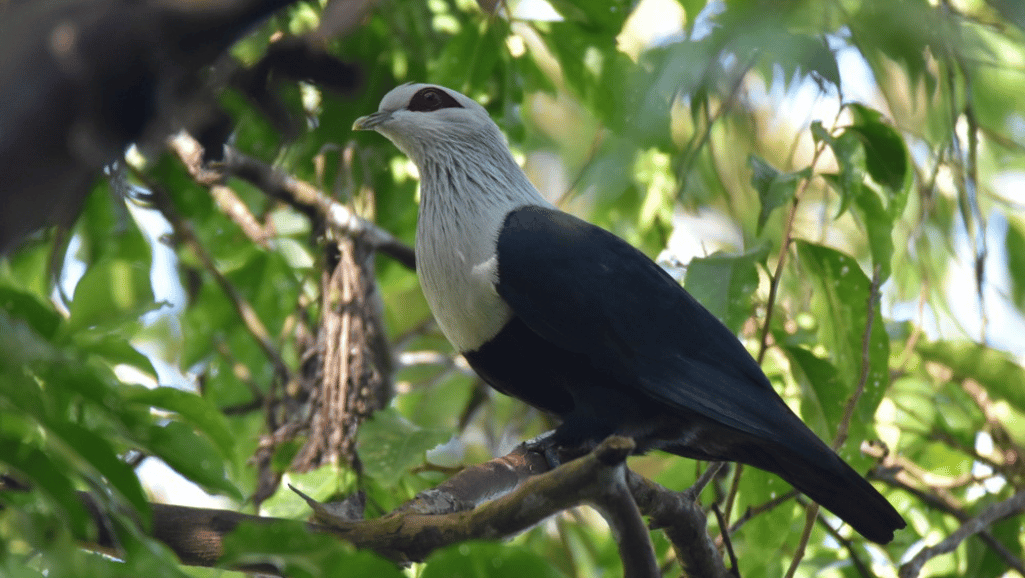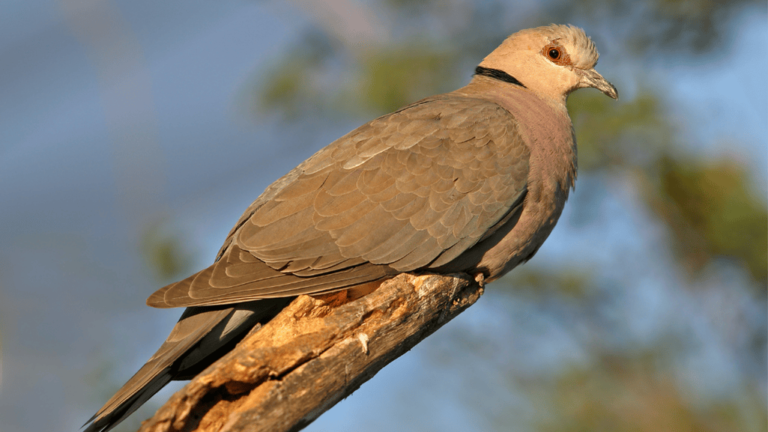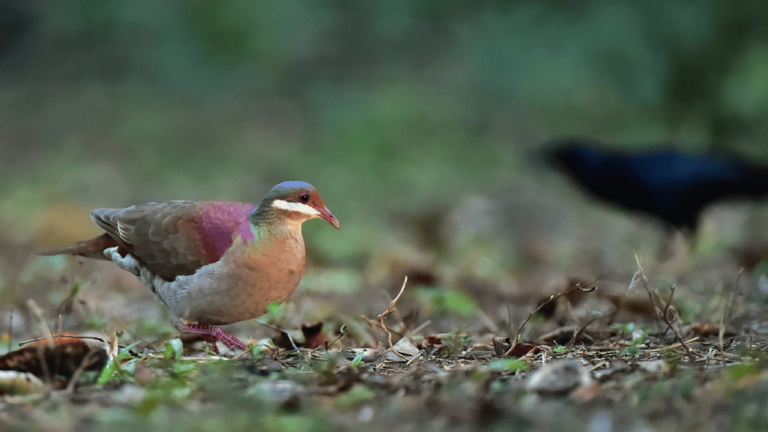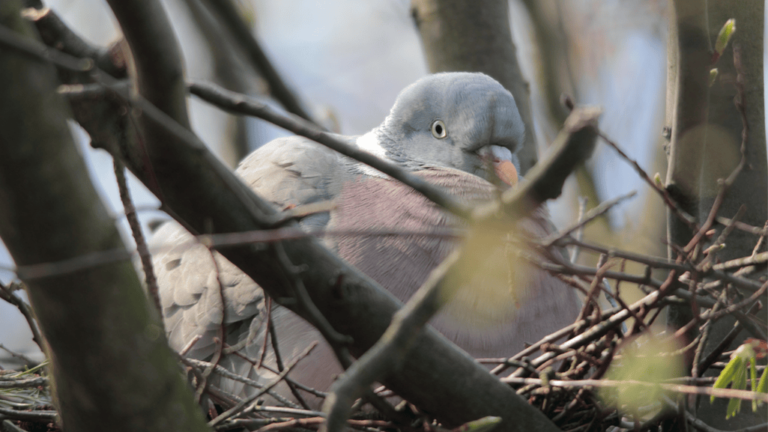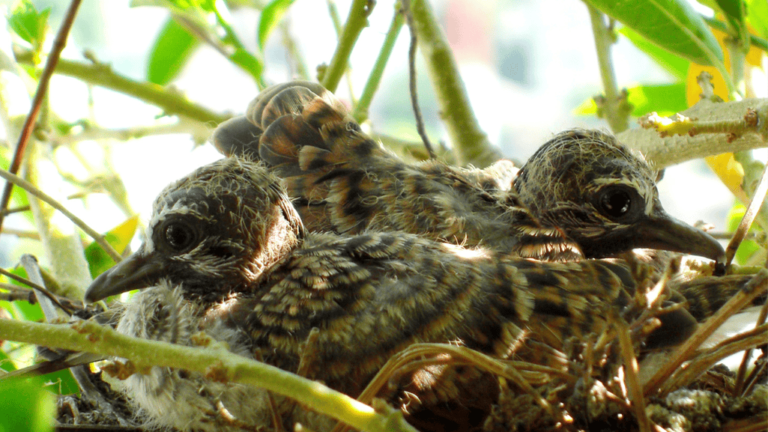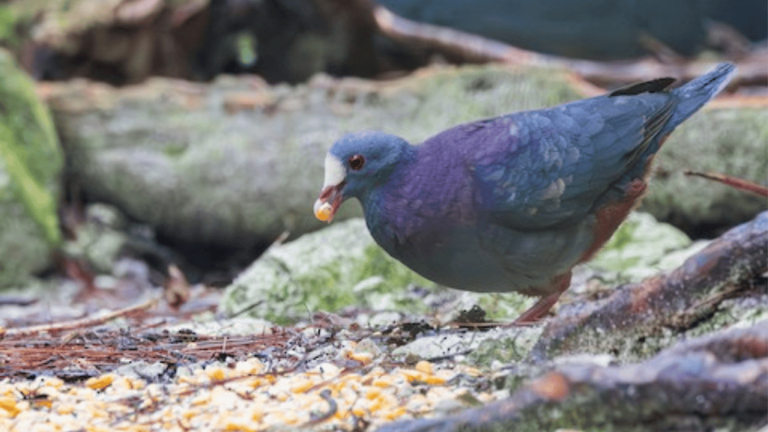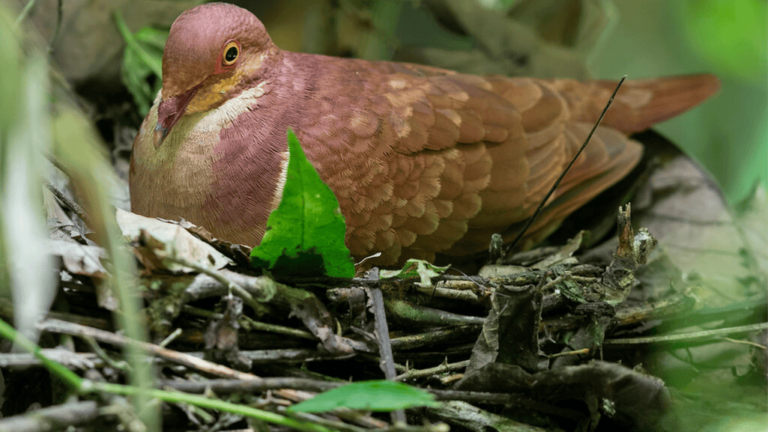The Comoro Blue Pigeon is a unique bird found only in the Comoros islands. It stands out with its dark blue color. These pigeons live in various places like rainforests, plantations, and dry coastal areas. They prefer high places and are often seen on tall trees or flying together in small groups.
But, these birds are in danger because of human actions. We need to learn more about where they live to help protect them. By studying their home, we can find new ways to save their numbers.
Key Takeaways
- Comoro Blue Pigeons are unique to the Comoros and Aldabra Atoll, showcasing vibrant dark blue hues.
- They thrive across a variety of habitats in the Comoros islands, including both pristine and altered landscapes.
- Raising awareness about the endangered bird species is integral to their conservation and the enhancement of local biodiversity.
- Focused efforts on wildlife protection are necessary to safeguard and study the Comoro Blue Pigeon habitat.
- Conservation strategies are most effective when based on a thorough understanding of the habitat needs and behaviors of the species in question.
Introduction to the Comoro Blue Pigeon
The Comoro Blue Pigeon is a mesmerizing bird found in the Comoros islands. It was first described in 1854 and was mistakenly thought to be from Madagascar. This rare bird species has a dark blue body and a pale gray hood. It is a sight to behold for those who get to see it.
This pigeon is sadly near threatened due to habitat loss and hunting. It lives in the Comoros’ beautiful but fragile ecosystems. This makes saving it even more urgent.
Bird watchers and conservationists see the need to protect the pigeon’s home. The islands’ forests are crucial for the pigeon’s survival. They are its main shelter.
- Monitoring bird populations to assess the impact of environmental changes.
- Implementing local conservation measures to safeguard its remaining habitats.
- Promoting eco-tourism that emphasizes the values of wildlife preservation.
With these efforts, we hope the Comoro Blue Pigeon will continue to fly over the Comoros. Learning about its needs and threats motivates us to create a safe home for it. This will help this rare bird species to flourish.
The Comoro Blue Pigeon: A Rarified Avian Jewel
The Comoro Blue Pigeon is a rare and beautiful bird from the Comoros Islands. It is well-known in ornithology circles. This bird has a stunning dark blue color and a pale head. These features make it a favorite among bird lovers and scientists.
Identification and Physical Description
The Comoro Blue Pigeon is easily recognized by its dark blue feathers and pale gray hood. This unique look sets it apart from other birds in the area. It also has a short tail and loves to fly high in fruiting trees. These trees are important for its food and home.
Behavioral Characteristics
This pigeon has special behaviors that help it live in the Comoros. It often eats fruits from tall trees. Sometimes, it hangs out in small groups, which might help it survive. This is important because it is a bird at risk.
Vocalizations and Calls
The pigeon makes low hoots or growls, which are unique sounds. These calls help it talk to other pigeons and are useful for scientists and birdwatchers. They know where to find the pigeon in the dense forests of the Comoros.
We need to protect this bird because it faces many threats. Knowing about its looks and behaviors is key to saving it. We must act to keep this amazing species safe for the future.
| Category | Count |
|---|---|
| Total Monotypic and Polytypic Groups | 20452 |
| Total Taxa | 34504 |
Endemic to Comoros: Understanding the Pigeon’s Native Environment
The Comoros archipelago is home to Grande Comore, Anjouan, and Mohéli, volcanic islands. These islands have a unique Comoros ecosystem vital for wildlife protection and biodiversity. They host many endemic bird species that thrive in the native vegetation and evergreen forests.
Ecosystems of the Comoros Islands
The islands are crucial for Comoros wildlife, with lush rainforests and montane zones up to 1,800 meters. This variety in altitude supports a wide range of life, from lowland birds to high-altitude specialists like the Karthala White-eye.
Species Diversity in Comoros
Over 160 bird species, including the Comoro Blue Pigeon, make the Comoros a haven for bird lovers. The best time to see these birds is from September to November. The islands are an endemic bird area, making them a key spot for birdwatching. Tours often include Mount Karthala, where you can see unique species in their native habitats. For more info, check out a detailed tour report.
Human Impact on Native Habitats
The Comoros ecosystem is under threat from habitat clearance and environmental degradation. This is mainly due to agriculture and urban growth. Groups like Dahari and Blue Ventures are fighting to protect the island’s unique species. They aim to reduce human impact and keep the biodiversity alive. Their efforts are key to fighting biodiversity loss and promoting sustainable living in local communities.
Comoro Blue Pigeon’s Preferred Habitats
The Comoro Blue Pigeon stands out for its unique habitat choices and behaviors. It shows how well it adapts to different places in the Comoros Islands. This part looks into where the pigeon likes to live, its flexibility, and what scientists learn from it.
Adaptations to Forest Life
In the high mountains, the Comoro Blue Pigeon has special traits that help it live up to 1,800 meters high. These traits are key in the dense forests where they find food and safety. The forests are vital for their survival, offering food and protection from danger.
Living Amongst Plantations
These birds also live in changed habitats like plantations. Changes in the environment often happen because of farming. But the Comoro Blue Pigeon makes the most of these new places. In plantations with banana trees, they find new homes and food, fitting right into their way of life.
Flight Patterns and Flocking Behavior
The way the Comoro Blue Pigeon flies shows a lively social life. They fly in small groups, which tells us about their social life and how they interact. Studying their flying and flocking behavior is crucial for research and saving this social bird species.
Keeping an eye on the Comoro Blue Pigeon’s homes, from forests to plantations, is key. This helps protect this bird and keeps the ecosystem balanced. It shows why we need to keep studying and protecting these birds and their homes.
Conservation Concerns for the Blue Pigeon
Even though some blue pigeon species are listed as “Least Concern,” we must keep a close watch. The loss of the Mauritius blue pigeon shows how vital it is to act. Species like the Comoro Blue Pigeon, which is Near Threatened, highlight how delicate their situation is.
Blue pigeons live in tropical forests and subtropical areas, up to 2,000 meters high. But, these places face threats from deforestation and city growth. This makes it crucial to have strong wildlife protection plans.
- Efforts should focus on saving their homes, fixing damaged areas, and stopping poaching.
- Getting local communities involved in conservation can make a big difference.
- It’s important to keep studying these birds and check their numbers often to adjust conservation plans as needed.
We need to tackle the threats these birds face to help them move from Near Threatened to a safer status. The loss of some species warns us of what could happen if we don’t act. This shows the urgency of ongoing conservation work.
Ornithological Significance of the Comoro Blue Pigeon
The Comoro Blue Pigeon brightens the bird world of the Comoros islands. It shows the ecological significance of keeping different bird species around. This pigeon is key for ornithological research and biodiversity studies.
Research and Studies
Its unique genes and adaptation to the Comoros make it a top study subject. Researchers look at how it lives and eats. This helps plan conservation efforts to protect it and other wildlife.
Contribution to Biodiversity
The Comoro Blue Pigeon adds to the Comoros’ rich bird diversity. It’s a key part of habitat protection plans. These efforts help keep the Comoros’ unique life systems safe.
Monitoring and Protection Efforts
Monitoring the Comoro Blue Pigeon helps check the health of its home. This work is key to getting support for its protection and other local species.
Every movement of the Comoro Blue Pigeon teaches us about the Comoros’ biodiversity. It guides policies on environmental monitoring and protection.
| Description | Location | Significance |
|---|---|---|
| Comoro Blue Pigeon (Alectroenas) Observations | Mount Karthala | Key habitat, high endemism |
| Genetic Studies | Comoros Archipelago | Data on evolutionary traits |
| Conservation Projects | Moheli Marine Park | Focus on habitat restoration |
Together, ornithological research, saving habitats, and community action are vital. They keep the Comoro Blue Pigeon and the islands’ ecosystems healthy.
The Role of Local Communities in Pigeon Conservation
Community engagement is key in protecting the balance of nature, especially in places like the Comoros. Here, the Comoro Blue Pigeon lives in a challenging environment. Local people are crucial in using sustainable practices to save the pigeon and keep the area’s biodiversity rich.
These communities understand how the pigeon and its home are connected. They work hard in conservation initiatives. They aim to stop habitat loss and illegal hunting, which threaten the pigeon’s survival.
By teaching and offering new job options, locals learn to choose conservation-friendly actions. This makes sustainable practices a part of their life. Educated and active locals are key to reaching conservation goals.
Data on local efforts shows how well community-led projects work:
| Initiative | Objective | Outcome |
|---|---|---|
| Tree Planting | To restore and expand forest habitats | Increased forest cover, providing nesting sites for pigeons |
| Environmental Education | Raise awareness about the importance of biodiversity | Higher community involvement in conservation initiatives |
| Alternative Livelihoods | Reduce reliance on forest resources | Promotion of sustainable practices and reduced habitat pressure |
The Comoros’ success with conservation initiatives can inspire others worldwide. By adopting sustainable practices and being active, local communities build a strong conservation framework. This approach helps protect the Comoro Blue Pigeon and keeps the ecosystem healthy.
Bird Watching in the Comoros: A Guide
For bird lovers and newcomers to wildlife tourism, a bird watching guide to the Comoros is a dream come true. Comoros birdwatching is exciting because of its unique birds that can’t be found anywhere else. It’s a top spot for bird experts and nature fans.
On a bird watching tour of the Comoros’ four main islands, you’ll see many different birds. You might see the Comoro Blue Pigeon, Grande Comoro Drongo, and Moheli Scops-Owl. These are just a few of the amazing birds you can find.
- Karthala White-eye
- Comoro Olive-Pigeon
- Anjouan Scops Owl
- Grand Comoro Flycatcher
- Mayotte Drongo
The Comoros is known as a top place for bird watching. It’s home to 19 special bird species in 9 Important Bird Areas (IBAs). This makes it a unique spot for bird lovers.
| Island | Endemics Spotted | Number of IBAs |
|---|---|---|
| Grand Comore | Comoro Blue Pigeon, Grande Comoro Drongo | 3 |
| Moheli | Moheli Scops-Owl, Moheli Sunbird | 2 |
| Anjouan | Anjouan Scops Owl, Anjouan Sunbird | 3 |
| Mayotte | Mayotte Drongo, Mayotte White-eye | 1 |
The wildlife tourism in the Comoros is made better by expert guides and organized tours. These tours offer places to stay, meals, and transport. The best time for Comoros birdwatching is from October to December. But the beautiful landscapes and wildlife are great all year.
Working with the bird watching guide and joining tours helps local conservation. It also lets visitors appreciate the Comoros’ nature more.
Conclusion
The story of the Comoro Blue Pigeon reminds us of how fragile our native species are. Human actions greatly affect wildlife. The Mauritius blue pigeon, a relative, went extinct in the 1830s due to habitat loss and predators. This teaches us the importance of conservation in the Comoros.
Studies show the unique behaviors and roles of the Comoro Blue Pigeon. This knowledge helps us protect these birds. We need to manage and watch the bird populations closely, especially on islands like Ngazidja.
Human actions keep changing the birds’ homes. We must find a balance to protect them. Sustainable wildlife tourism can help by making people appreciate these birds and support their protection.
Working with local communities and promoting sustainable tourism is key. This approach can protect the Comoros’ ecology and our planet’s natural heritage. By doing so, we can prevent the loss of species like the Comoro Blue Pigeon and keep them for future generations.


